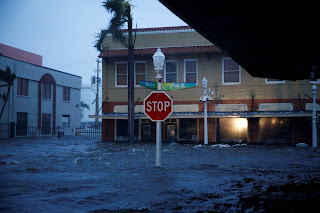Florida State Governor Ron DeSantis has announced the deployment of 7 000 National Guard troops to lead rescue operations in flood zones. One of the most dangerous storms to hit the US in years has left millions of homes without power and floodwaters surging inland.
Ian blasted ashore at the barrier island of Cayo Costa on Wednesday afternoon as a Category 4 hurricane with maximum sustained winds of 241 kph. An unspecified number of people were stranded after choosing to ride it out at home rather than heed evacuation orders, Florida Governor Ron DeSantis said.
Rescue workers and residents of Florida's Gulf Coast searched for missing people and picked up the pieces from wrecked homes on Thursday after Hurricane Ian tore through the area with howling winds, torrential rains and raging surf and caused massive power outages.
One of the mightiest storms to hit the U.S. mainland in recent years, Ian flooded communities before plowing across the peninsula to the Atlantic seaboard. Local power companies said more than 2.5 million homes and businesses in Florida remained without power.
Governor Ron DeSantis said that Lee and Charlotte counties, home to more than 900,000 people, were "basically off the grid."
Ian blasted ashore at the barrier island of Cayo Costa on Wednesday afternoon as a Category 4 hurricane with maximum sustained winds of 150 miles per hour (241 kph). It rapidly transformed Florida's southwestern shoreline, dotted with sandy beaches, coastal towns and mobile home parks, into a disaster zone as it swept seawater into waterfront homes.
"The impacts of this storm are historic and the damage that was done was historic," DeSantis said during a news briefing. "We have never seen a flood event like this. We have never seen storm surge of this magnitude."
There were two unconfirmed storm-related fatalities, DeSantis said. The extent of deaths and injuries was unclear on Thursday morning as rescue workers were only starting to respond to calls after not being able to go out during the treacherous conditions.
DeSantis said 28 helicopters were performing water rescues. He also said the bridge to Sanibel Island - a barrier island on the Gulf coast - was severely damaged and impassible. Two area hospitals were evacuated, with patients moved to higher ground.
In the early morning hours after it passed, residents and rescue workers in hard-hit areas like Venice, located in Sarasota County about 75 miles (120 km) south of Tampa, hunted for family and friends as trees, debris and power lines covered roads and standing water washed over the ground.
Kurt Hoffman, sheriff of Sarasota County, told residents in a Twitter post that there were more than 500 calls for help and that they are "triaging" them for the most urgent.
"Patrol deputies resumed operations a few hours ago, are responding to the highest priority calls first," Hoffman wrote. "Sit tight, we know many of you need help."
The search for loved ones was made more difficult as cellphone services were often cut.
"A lot of down trees, a lot of flooding everywhere. We are trying to get a hold of my daughter," said Terri Byrd as she sat in a vehicle in a Walmart parking lot trying to get cell service after spending the night at an elementary school in Venice.
DISASTER DECLARATION
Ian, now a tropical storm, slackened as it trekked across Florida but was still producing strong winds, heavy rains and storm surge, including in Georgia, South Carolina and North Carolina, the U.S. National Hurricane Center said.
The storm, packing maximum sustained winds of 65 mph (100 kph), was about 40 miles (70 km) southeast of Orlando, the Miami-based forecaster said. It was expected to reach the Atlantic Coast on Thursday afternoon, unleashing drenching rains and threatening to bring more extensive flooding. Up to 30 inches (76 cm) of rain was forecast to fall on parts of central Florida, the hurricane center said.
President Joe Biden spoke to DeSantis on Thursday, saying his administration was committed to continue close coordination and that Federal Emergency Management Agency Director Deanne Criswell will be in Florida on Friday.
Biden also approved a disaster declaration, making federal resources available to the counties impacted by the storm.
The damages caused by Ian will turn out to be catastrophic and FEMA is preparing for potentially thousands of people to be displaced in the long-term, Criswell told CNN.
"I don't think that we can quantify it yet," Criswell said when asked about damages from the storm. "But I can tell you that it is going to be catastrophic."
She said FEMA was preparing for thousands of long-term displaced people in the region, as large population centers were hit as well as families living in mobile homes.
Some utilities had started to restore power for customers now that the storm has passed southern Florida but the number of outages increased as the storm moved across Florida.
Communications were nearly impossible in many spots. Video images of the storm’s fury on local TV and social media showed flood water nearly reaching rooftops in some communities, sweeping away cars and the ruins of homes as palm trees were bent almost in half. Many mobile home residents took refuge in local schools and other facilities converted to emergency shelters.
The area’s numerous assisted-living facilities were mostly evacuated too. DeSantis said Ian had generated life-threatening storm surges waves of wind-driven seawater rushing in along the coast of up to 3.7 meters in some places.
“This is a storm that we will talk about for many years to come, an historic event,” says Ken Graham, director of the National Weather Service











